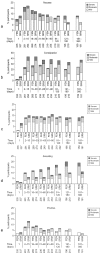Predicting long-term response to strong opioids in patients with low back pain: findings from a randomized, controlled trial of transdermal fentanyl and morphine
- PMID: 18154644
- PMCID: PMC2242794
- DOI: 10.1186/1741-7015-5-39
Predicting long-term response to strong opioids in patients with low back pain: findings from a randomized, controlled trial of transdermal fentanyl and morphine
Abstract
Background: Some patients with long-standing low back pain will benefit from treatment with strong opioids. However, it would be helpful to predict which patients will have a good response. A fixed-term opioid trial has been recommended, but there is little evidence to suggest how long this trial should be. We assessed data from a large-scale randomized comparison of transdermal fentanyl (TDF) and sustained-release oral morphine (slow-release morphine; SRM) to determine characteristics of treatment responders.
Methods: This was a secondary analysis of a previously published 13-month randomized trial involving 680 patients with long-standing low back pain (median age 52 years, 61% women, median duration of back pain 87 months). Pain relief was recorded using visual analogue scales (VAS). Treatment response was defined as pain relief of at least 30% from baseline to any point during the trial. We used a step-wise logistic regression to identify variables that might predict response to treatment. Covariates included treatment group, sex, age, duration of pain, presence of neuropathic pain, baseline pain scores, educational/employment status, use of high doses of opioids, and social functioning (SF)-36 scores.
Results: Over half the patients in both groups (n = 370; 54% TDF, 55% SRM) were treatment responders. There were no differences between the TDF and SRM responders in terms of age, sex, type or duration of pain between responders and non-responders. The difference in response to treatment between responders and non-responders could be detected at 3 weeks. Lack of response after 1 month had a stronger negative predictive value (i.e., ability to detect non-responders) than the presence of response after 1 month. The most influential factors for predicting a response were employment status (chi2 = 11.06, p = 0.0259) and use of high doses of opioids (chi2 = 3.04, p = 0.0811).
Conclusion: No clear pattern of baseline pain (type or severity) or patient characteristics emerged that could be used to predict responders before the start of opioid treatment. However, a 1-month trial period appears sufficient to determine response and tolerability in most cases.
Figures



Similar articles
-
Opioids and the management of chronic severe pain in the elderly: consensus statement of an International Expert Panel with focus on the six clinically most often used World Health Organization Step III opioids (buprenorphine, fentanyl, hydromorphone, methadone, morphine, oxycodone).Pain Pract. 2008 Jul-Aug;8(4):287-313. doi: 10.1111/j.1533-2500.2008.00204.x. Epub 2008 May 23. Pain Pract. 2008. PMID: 18503626
-
Transdermal fentanyl versus sustained release oral morphine in strong-opioid naïve patients with chronic low back pain.Spine (Phila Pa 1976). 2005 Nov 15;30(22):2484-90. doi: 10.1097/01.brs.0000186860.23078.a8. Spine (Phila Pa 1976). 2005. PMID: 16284584 Clinical Trial.
-
Comparison of TTS-fentanyl with sustained-release oral morphine in the treatment of patients not using opioids for mild-to-moderate pain.Curr Med Res Opin. 2003;19(6):457-69. doi: 10.1185/030079903125002045. Curr Med Res Opin. 2003. PMID: 14594516 Clinical Trial.
-
An observational study of health-related quality of life and pain outcomes in chronic low back pain patients treated with fentanyl transdermal system.Curr Med Res Opin. 2005 Jun;21(6):849-62. doi: 10.1185/030079905X46377. Curr Med Res Opin. 2005. PMID: 15969885
-
Efficacy and adverse effects of transdermal fentanyl and sustained-release oral morphine in treating moderate-severe cancer pain in Chinese population: a systematic review and meta-analysis.J Exp Clin Cancer Res. 2010 Jun 9;29(1):67. doi: 10.1186/1756-9966-29-67. J Exp Clin Cancer Res. 2010. PMID: 20529380 Free PMC article.
Cited by
-
Duloxetine 60 mg for chronic low back pain: post hoc responder analysis of double-blind, placebo-controlled trials.J Pain Res. 2017 Jul 24;10:1723-1731. doi: 10.2147/JPR.S138297. eCollection 2017. J Pain Res. 2017. PMID: 28769588 Free PMC article.
-
Effects of the COVID-19 pandemic on chronic pain in Spain: a scoping review.Pain Rep. 2021 Feb 16;6(1):e899. doi: 10.1097/PR9.0000000000000899. eCollection 2021 Jan-Feb. Pain Rep. 2021. PMID: 33615089 Free PMC article.
-
Health-related quality of life in patients receiving long-term opioid therapy: a systematic review with meta-analysis.Qual Life Res. 2017 Aug;26(8):1955-1967. doi: 10.1007/s11136-017-1538-0. Epub 2017 Mar 2. Qual Life Res. 2017. PMID: 28255745 Free PMC article.
-
Psychological variables potentially implicated in opioid-related mortality as observed in clinical practice.Pain Med. 2011 Jun;12 Suppl 2(0 2):S36-42. doi: 10.1111/j.1526-4637.2011.01130.x. Pain Med. 2011. PMID: 21668755 Free PMC article.
-
Opioids for neuropathic pain.Cochrane Database Syst Rev. 2013 Aug 29;2013(8):CD006146. doi: 10.1002/14651858.CD006146.pub2. Cochrane Database Syst Rev. 2013. PMID: 23986501 Free PMC article.
References
-
- Axen I, Jones JJ, Rosenbaum A, Lovgren PW, Halasz L, Larsen K, Leboeuf-Yde C. The Nordic Back Pain Subpopulation Program: validation and improvement of a predictive model for treatment outcome in patients with low back pain receiving chiropractic treatment. J Manip Physiol Ther. 2005;28:381–385. doi: 10.1016/j.jmpt.2005.06.008. - DOI - PubMed
Publication types
MeSH terms
Substances
LinkOut - more resources
Full Text Sources

